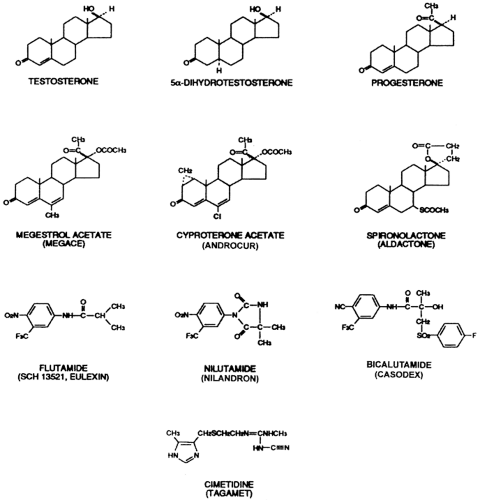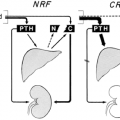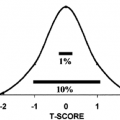ANTIANDROGENS
Antiandrogens are drugs that antagonize the actions of androgens by binding to or interacting with androgen receptors and competitively or noncompetitively inhibiting the binding of endogenous androgens.These drugs were developed for use in hormonal treatment of androgen-dependent malignancies, such as prostatic carcinoma and breast carcinoma in men. Subsequently, antiandrogens have been used to treat a variety of nonmalignant androgen-dependent conditions, such as acne, hirsutism, hyperandrogenism in women, male pattern baldness, and hypersexuality in men. The therapeutic advantage of antiandrogens over gonadal androgen suppression (e.g., with a GnRH analog) in the treatment of androgen-dependent disorders is that they antagonize the actions of both gonadal and adrenal androgens. When they are administered alone to patients with intact hypothalamic–pituitary–gonadal axes, however, the activation of normal feedback mechanisms may lead to increased testosterone production, which counteracts the actions of antiandrogens. Fortunately, many antiandrogens also have suppressive effects on pituitary gonadotropin secretion that limit the normal feedback increase of gonadotropins.
PROGESTERONE
Progesterone (Fig. 119-3) and other progestogens are weak antiandrogens. Their interactions with androgen target tissues are complex, however, because they also have inhibitory effects on androgen production, potent direct progestational actions of their own on these tissues, some antiestrogenic action, and suppressive effects on gonadotropin secretion (antigonadotropic action). Some derivatives of progesterone (e.g., megestrol acetate and cyproterone acetate) have potent antiandrogenic action.
MEGESTROL ACETATE
The progestational antiandrogen megestrol acetate (see Fig. 119-3) significantly blocks androgen production and androgen-mediated action at doses of 120 to 160 mg per day.165 When administered alone, megestrol acetate profoundly suppresses serum gonadotropin and testosterone levels. In patients with intact hypothalamic–pituitary–gonadal axes, however, partial escape from this suppressive effect occurs, with serum testosterone levels returning toward control levels after 5 months. The
addition of estradiol (0.5–1.5 mg per day) or diethylstilbestrol (0.1–0.2 mg per day) to the megestrol acetate (80–160 mg per day) maintains castrate levels of serum testosterone. These combinations have been used in the treatment of metastatic prostate cancer (see Chap. 225).165 Megestrol acetate has also been used in the treatment of breast cancer and in management of the anorexia and cachexia associated with malignancy and AIDS, and for prevention of hot flashes.98,166,167 One should note, however, that megestrol acetate may suppress endogenous gonadotropin and testosterone secretion in men, resulting in decreases in muscle mass and increases in fat mass.168 Because it has glucocorticoid-like activity, high-dosage megestrol acetate may also cause clinical adrenal insufficiency and Cushing syndrome.169,170
addition of estradiol (0.5–1.5 mg per day) or diethylstilbestrol (0.1–0.2 mg per day) to the megestrol acetate (80–160 mg per day) maintains castrate levels of serum testosterone. These combinations have been used in the treatment of metastatic prostate cancer (see Chap. 225).165 Megestrol acetate has also been used in the treatment of breast cancer and in management of the anorexia and cachexia associated with malignancy and AIDS, and for prevention of hot flashes.98,166,167 One should note, however, that megestrol acetate may suppress endogenous gonadotropin and testosterone secretion in men, resulting in decreases in muscle mass and increases in fat mass.168 Because it has glucocorticoid-like activity, high-dosage megestrol acetate may also cause clinical adrenal insufficiency and Cushing syndrome.169,170
CYPROTERONE ACETATE
Cyproterone acetate (see Fig. 119-3) is a synthetic hydroxy-progesterone derivative that has potent antiandrogenic, progestational, and antigonadotropic actions.171 It also suppresses gonadal testosterone biosynthesis by inhibiting 17,20-desmolase enzyme activity. It is commonly used in many countries but is not available in the United States. At doses of 200 to 300 mg per day, cyproterone acetate has been used to achieve short-term responses in the treatment of prostatic and male breast carcinoma and, in combination with GnRH analogs or orchidectomy, to achieve complete androgen blockade in patients with metastatic prostate cancer.172,173 The potent progestational and antigonadotropic actions of cyproterone acetate inhibit feedback stimulation of gonadotropin secretion during its administration. A combination of low-dose cyproterone acetate (2 mg) and cyclical ethinyl estradiol (e.g., 35 μg [Dianette] and 50 μg [Diane]) has been used with variable success to treat acne, hirsutism, and hyperandrogenism in women (see Chap. 101).171,174,175 No significant difference is found in the overall efficacy of high-dose (100 mg) compared with low-dose cypro-terone acetate in the treatment of acne and hirsutism. More severe degrees of androgenization in women, however, may require higher dosage regimens (50–100 mg). Because of its potent progestational and antigonadotropic actions, cyproter-one acetate causes menstrual abnormalities (e.g., oligomenorrhea, amenorrhea, and dysmenorrhea), as well as breast engorgement and gastrointestinal upset, which limit its use in nonmalignant conditions. In high doses, it may cause impairment of adrenocortical function. To reduce side effects, a topical cyproterone acetate lotion is being tested for the treatment of acne. The combination of cyproterone acetate and testosterone enanthate suppresses sperm production very effectively in normal men, suggesting that combinations of an androgen plus an antiandrogenic progestogen may hold promise for male contraceptive development.176
Stay updated, free articles. Join our Telegram channel

Full access? Get Clinical Tree







